Dynamics of Fire Foci in the Amazon Rainforest and Their Consequences on Environmental Degradation
Abstract
:1. Introduction
2. Materials and Methods
2.1. Study Area
2.2. Fire Foci
2.3. Applied Statistic
2.4. Deforestation Monitoring Data (PRODES and DETER)
2.5. Biophysical Parameters
2.6. ENSO Data
2.7. Burned Areas Via Fire MapBiomas
3. Results
3.1. Statistical Analysis
3.2. Biophysical Parameters
3.3. Fire Foci Versus Deforestation (PRODES/DETER)
3.4. Dynamics of the Total Annual Burned Area
4. Discussion
5. Conclusions
Supplementary Materials
Author Contributions
Funding
Acknowledgments
Conflicts of Interest
References
- Andela, N.; Morton, D.C.; Giglio, L.; Chen, Y.; Van der Werf, G.R.; Kasibhatla, P.S.; Defries, R.S.; Collatz, G.J.; Hantson, S.; Randerson, J.T. A human-driven decline in global burned area. Science 2017, 356, 1356–1362. [Google Scholar] [CrossRef] [PubMed] [Green Version]
- Wei, M.; Zhang, Z.; Long, T.; He, G.; Wang, G. Monitoring Landsat based burned area as an indicator of Sustainable Development Goals. Earth’s Future 2021, 9, e2020EF001960. [Google Scholar] [CrossRef]
- Andreae, M.O. Emission of trace gases and aerosols from biomass burning—An updated assessment. Atmos Chem. Phys. 2019, 19, 8523–8546. [Google Scholar] [CrossRef] [Green Version]
- Amigo, I. When will the Amazon hit a tipping point? Nature 2020, 578, 505–508. [Google Scholar] [CrossRef] [Green Version]
- Castellanos, P.; Boersma, K.F.; Van Der Werf, G.R. Satellite observations indicate substantial spatiotemporal variability in biomass burning NO x emission factors for South America. Atmos. Chem. Phys. 2014, 14, 3929–3943. [Google Scholar] [CrossRef] [Green Version]
- Farahmand, A.; Stavros, E.N.; Reager, J.T.; Behrangi, A.; Randerson, J.T.; Quayle, B. Satellite hydrology observations as operational indicators of forecasted fire danger across the contiguous United States. Nat. Hazards Earth Sys. Sci. 2020, 20, 1097–1106. [Google Scholar] [CrossRef] [Green Version]
- Bondur, V.G.; Tsidilina, M.N.; Cherepanova, E.V. Satellite monitoring of wildfire impacts on the conditions of various types of vegetation cover in the federal districts of the Russian Federation. Izv. Atmos. Ocean. Phys. 2019, 55, 1238–1253. [Google Scholar] [CrossRef]
- Shah, M.; Calabia, A.; Tariq, M.A.; Ahmed, J.; Ahmed, A. Possible ionosphere and atmosphere precursory analysis related to Mw > 6.0 earthquakes in Japan. Remote Sens. Environ. 2020, 239, 111620. [Google Scholar] [CrossRef]
- Chen, X.; Quan, Q.; Zhang, K.; Wei, J. Spatiotemporal characteristics and attribution of dry/wet conditions in the Weihe River Basin within a typical monsoon transition zone of East Asia over the recent 547 years. Environ. Model. Softw. Environ. Data News 2021, 143, 105116. [Google Scholar] [CrossRef]
- Zhang, K.; Ali, A.; Antonarakis, A.; Moghaddam, M.; Saatchi, S.; Tabatabaeenejad, A.; Chen, R.; Jaruwatanadilok, S.; Cuenca, R.; Crow, W.T.; et al. The Sensitivity of North American Terrestrial Carbon Fluxes to Spatial and Temporal Variation in Soil Moisture: An Analysis Using Radar-Derived Estimates of Root-Zone Soil Moisture. J. Geophys. Res. Biogeosciences 2019, 124, 3208–3231. [Google Scholar] [CrossRef]
- Liu, Y.; Zhang, K.; Li, Z.; Liu, Z.; Wang, J.; Huang, P. A hybrid runoff generation modelling framework based on spatial combination of three runoff generation schemes for semi-humid and semi-arid watersheds. J. Hydrol. 2020, 590, 125440. [Google Scholar] [CrossRef]
- Wang, S.; Zhang, K.; Chao, L.; Li, D.; Tian, X.; Bao, H.; Xia, Y. Exploring the utility of radar and satellite-sensed precipitation and their dynamic bias correction for integrated prediction of flood and landslide hazards. J. Hydrol. 2021, 603, 126964. [Google Scholar] [CrossRef]
- Liu, S.; Liu, Y.; Wang, C.; Dang, X. The Distribution Characteristics and Human Health Risks of High- Fluorine Groundwater in Coastal Plain: A Case Study in Southern Laizhou Bay, China. Front. Environ. Sci. 2022, 10, 568. [Google Scholar] [CrossRef]
- Hu, S.; Wu, H.; Liang, X.; Xiao, C.; Zhao, Q.; Cao, Y.; Han, X. A preliminary study on the eco-environmental geological issue of in-situ oil shale mining by a physical model. Chemosphere 2022, 287, 131987. [Google Scholar] [CrossRef] [PubMed]
- Zhao, T.; Shi, J.; Lv, L.; Xu, H.; Chen, D.; Cui, Q.; Zhang, Z. Soil moisture experiment in the Luan River supporting new satellite mission opportunities. Remote Sens. Environ. 2020, 240, 111680. [Google Scholar] [CrossRef]
- Chéret, V.; Denux, J.P. Mapping wildfire danger at regional scale with an index model integrating coarse spatial resolution remote sensing data. J. Geophys. Res. Biogeosci. 2007, 112, 1–11. [Google Scholar] [CrossRef] [Green Version]
- Jolly, W.M.; Cochrane, M.A.; Freeborn, P.H.; Holden, Z.A.; Brown, T.J.; Williamson, G.J.; Bowman, D.M. Climate-induced variations in global wildfire danger from 1979 to 2013. Nat. Commun. 2015, 6, 7537. [Google Scholar] [CrossRef]
- Pereira, G.; Longo, K.M.; Freitas, S.R.; Mataveli, G.; Oliveira, V.J.; Santos, P.R.; Cardozo, F.S. Improving the south America wildfires smoke estimates: Integration of polar-orbiting and geostationary satellite fire products in the Brazilian biomass burning emission model (3BEM). Atmos. Environ. 2022, 273, 118954. [Google Scholar] [CrossRef]
- Tecle, A.; Neary, D. Water quality impacts of forest fires. Pollut. Eff. Control 2015, 3, 25–40. [Google Scholar] [CrossRef]
- Reid, C.E.; Brauer, M.; Johnston, F.H.; Jerrett, M.; Balmes, J.R.; Elliott, C.T. Critical review of health impacts of wildfire smoke exposure. Environ. Health Perspect. 2016, 124, 1334–1343. [Google Scholar] [CrossRef] [Green Version]
- Nepstad, D.; McGrath, D.; Alencar, A.; Barros, A.C.; Carvalho, G.; Santilli, M.; Vera Diaz, M. Frontier Governance in Amazonia. Science 2002, 295, 629–631. [Google Scholar] [CrossRef] [PubMed] [Green Version]
- Caúla, R.H.; Oliveira-Júnior, J.F.; Lyra, G.B.; Delgado, R.C.; Heilbron Filho, P.F.L. Overview of Fire Foci Causes and Locations in Brazil Based on Meteorological Satellite Data from 1998 to 2011. Environ. Earth Sci. 2015, 74, 1497–1508. [Google Scholar] [CrossRef]
- Lima, M.; do Vale, J.C.E.; Costa, G.D.M.; dos Santos, R.C.; Correia Filho, W.L.F.; Gois, G.; de Oliveira-Junior, J.F.; Teodoro, P.E.; Rossi, F.S.; da Silva Junior, C.A. The Forests in the Indigenous Lands in Brazil in Peril. Land Use Policy 2020, 90, 104258. [Google Scholar] [CrossRef]
- Shrivastava, M.; Andreae, M.O.; Artaxo, P.; Barbosa, H.M.J.; Berg, L.K.; Brito, J.; Ching, J.; Easter, R.C.; Fan, J.; Fast, J.D.; et al. Urban Pollution Greatly Enhances Formation of Natural Aerosols over the Amazon Rainforest. Nat. Commun. 2019, 10, 1046. [Google Scholar] [CrossRef] [Green Version]
- Oliveira-Júnior, J.F.; Teodoro, P.E.; Silva Junior, C.A.; Baio, F.H.R.; Gava, R.; Capristo-Silva, G.F.; Gois, G.; Correia Filho, W.L.F.; Lima, M.; de Santiago, D.B.; et al. Fire Foci Related to Rainfall and Biomes of the State of Mato Grosso do Sul, Brazil. Agric. For. Meteorol. 2020, 282–283, 107861. [Google Scholar] [CrossRef]
- De Sales, F.; Santiago, T.; Biggs, T.W.; Mullan, K.; Sills, E.O.; Monteverde, C. Impacts of Protected Area Deforestation on Dry-Season Regional Climate in the Brazilian Amazon. J. Geophys. Res. Atmos. 2020, 125, e2020JD033048. [Google Scholar] [CrossRef]
- Sato, H.; Kelley, D.I.; Mayor, S.J.; Martin Calvo, M.; Cowling, S.A.; Prentice, I.C. Dry Corridors Opened by Fire and Low CO2 in Amazonian Rainforest during the Last Glacial Maximum. Nat. Geosci. 2021, 14, 578–585. [Google Scholar] [CrossRef]
- Chen, Y.; Velicogna, I.; Famiglietti, J.S.; Randerson, J.T. Satellite observations of terrestrial water storage provide early warning information about drought and fire season severity in the Amazon. J. Geophys. Res. Biogeosci. 2013, 118, 495–504. [Google Scholar] [CrossRef] [Green Version]
- Ray, D.; Nepstad, D.; Moutinho, P. Micrometeorological and canopy controls of fire susceptibility in a forested Amazon landscape. Ecol. Appl. 2005, 15, 1664–1678. [Google Scholar] [CrossRef]
- Aragão, L.E.; Anderson, L.O.; Fonseca, M.G.; Rosan, T.M.; Vedovato, L.B.; Wagner, F.H.; Saatchi, S. 21st Century drought-related fires counteract the decline of Amazon deforestation carbon emissions. Nat. Commun. 2018, 9, 536. [Google Scholar] [CrossRef] [PubMed]
- Langmann, B.; Duncan, B.; Textor, C.; Trentmann, J.; Van Der Werf, G.R. Vegetation fire emissions and their impact on air pollution and climate. Atmos. Environ. 2009, 43, 107–116. [Google Scholar] [CrossRef]
- Giglio, L.; Schroeder, W.; Justice, C.O. The collection 6 MODIS active fire detection algorithm and fire products. Remote Sens. Environ. 2016, 178, 31–41. [Google Scholar] [CrossRef] [PubMed] [Green Version]
- Bondur, V.G.; Gordo, K.A.; Kladov, V.L. Spacetime distributions of wildfire areas and emissions of carbon-containing gases and aerosols in northern Eurasia according to satellite-monitoring data. Izv. Atmos. Ocean. Phys. 2017, 53, 859–874. [Google Scholar] [CrossRef]
- Marinho, A.A.R.; Gois, G.; Oliveira-Júnior, J.F.; Correia Filho, W.L.F.; Santiago, D.B.; da Silva Junior, C.A.; Teodoro, P.E.; Souza, A.; Capristo-Silva, G.F.; Freitas, W.K. Temporal Record and Spatial Distribution of Fire Foci in State of Minas Gerais, Brazil. J. Environ. Manag. 2021, 280, 111707. [Google Scholar] [CrossRef] [PubMed]
- CPTEC/INPE Centro de Previsão Do Tempo e Estudos Climáticos/Instituto Nacional de Pesquisas Espaciais. Monitoramento de Focos de Calor. 2020. Available online: https://www.cptec.inpe.br/ (accessed on 4 June 2022).
- Souza, A. Metodologia Utilizada Nos Projetos PRODES e DETER; INPE: São José dos Campos, Brazil, 2019; p. 33. [Google Scholar]
- IBGE—Instituto Brasileiro de Geografia e Estatistica. Geoestatística de Recursos Naturais da Amazôni; IBGE: Brasília, Brazil, 2020. [Google Scholar]
- Alvares, C.A.; Stape, J.L.; Sentelhas, P.C.; Moraes, G.J.L.; Sparovek, G. Köppen’s Climate Classification Map for Brazil. Meteorol. Zeitschrift 2013, 22, 711–728. [Google Scholar] [CrossRef]
- ORIGIN (Pro) 3.6 Version; OriginLab Corporation: Northampton, MA, USA, 2019.
- da Silva, M.V.; Pandorfi, H.; Lopes, P.M.O.; da Silva, J.L.B.; de Almeida, G.L.P.; Silva, D.A.D.O.; dos Santos, A.; Rodrigues, J.A.D.M.; Batista, P.H.D.; Jardim, A.M.D.R.F. Pilot Monitoring of Caatinga Spatial-Temporal Dynamics through the Action of Agriculture and Livestock in the Brazilian Semiarid. Remote Sens. Appl. Soc. Environ. 2020, 19, 100353. [Google Scholar] [CrossRef]
- da Silva, M.V.; Pandorfi, H.; de Almeida, G.L.P.; de Lima, R.P.; dos Santos, A.; Jardim, A.M.D.R.F.; Rolim, M.M.; da Silva, J.L.B.; Batista, P.H.D.; da Silva, R.A.B.; et al. Spatio-Temporal Monitoring of Soil and Plant Indicators under Forage Cactus Cultivation by Geoprocessing in Brazilian Semi-Arid Region. J. S. Am. Earth Sci. 2021, 107, 103155. [Google Scholar] [CrossRef]
- Jardim, A.M.D.R.F.; da Silva, M.V.; Silva, A.R.; dos Santos, A.; Pandorfi, H.; de Oliveira-Júnior, J.F.; de Lima, J.L.; de Souza, L.S.B.; Júnior, G.D.N.A.; Lopes, P.M.O.; et al. Spatiotemporal Climatic Analysis in Pernambuco State, Northeast Brazil. J. Atmos. Solar-Terr. Phys. 2021, 223, 105733. [Google Scholar] [CrossRef]
- Kaiser, H.F. The Application of Electronic Computers to Factor Analysis. Educ. Psychol. Meas. 1960, 20, 141–151. [Google Scholar] [CrossRef]
- Jardim, A.M.D.R.F.; Santos, H.R.B.; Alves, H.K.M.N.; Ferreira-Silva, S.L.; de Souza, L.S.B.; Júnior, G.D.N.A.; Souza, M.D.S.; de Araújo, G.G.L.; de Souza, C.A.A.; da Silva, T.G.F. Genotypic Differences Relative Photochemical Activity, Inorganic and Organic Solutes and Yield Performance in Clones of the Forage Cactus under Semi-Arid Environment. Plant Physiol. Biochem. 2021, 162, 421–430. [Google Scholar] [CrossRef]
- R Core Team. R: A Language and Environment for Statistical Computing; R Foundation for Statistical Computing: Vienna, Austria, 2022. [Google Scholar]
- Jiang, Z.; Huete, A.R.; Chen, J.; Chen, Y.; Li, J.; Yan, G.; Zhang, X. Analysis of NDVI and Scaled Difference Vegetation Index Retrievals of Vegetation Fraction. Remote Sens. Environ. 2006, 101, 366–378. [Google Scholar] [CrossRef]
- Shah, M.; Jin, S. Statistical characteristics of seismo-ionospheric GPS TEC disturbances prior to global Mw≥5.0 earthquakes (1998–2014). J. Geodyn. 2015, 92, 42–49. [Google Scholar] [CrossRef]
- Tasumi, M.; Allen, R.G.; Trezza, R. At-Surface Reflectance and Albedo from Satellite for Operational Calculation of Land Surface Energy Balance. J. Hydrol. Eng. 2008, 13, 51–63. [Google Scholar] [CrossRef]
- Allen, R.G.; Masahiro, T.; Ricardo, T. Satellite-Based Energy Balance for Mapping Evapotranspiration with Internalized Calibration (METRIC)—Model. J. Irrig. Drain. Eng. 2007, 133, 380–394. [Google Scholar] [CrossRef]
- Allen, R.G.; Tasumi, M.; Trezza, R.; Waters, R.; Bastiaanssen, W.G.M. SEBAL (Surface Energy Balance Algorithms for Land). Advance Training and Users Manual–Idaho Implementation; Springer: Dordrecht, The Netherland, 2002; p. 97. [Google Scholar]
- Shah, M.; Ehsan, M.; Abbas, A.; Ahmed, A.; Jamjareegulgarn, P. Possible Thermal Anomalies Associated with Global Terrestrial Earthquakes During 2000–2019 Based on MODIS-LST. IEEE Geosci. Remote Sens. Lett. 2022, 19, 1002705. [Google Scholar] [CrossRef]
- Nascimento, A.C.L.; Galvani, E.; Gobo, J.P.A.; Wollmann, C.A. Comparison between Air Temperature and Land Surface Temperature for the City of São Paulo, Brazil. Atmosphere 2022, 13, 491. [Google Scholar] [CrossRef]
- Jardim, A.M.; Araújo Júnior, G.D.; Silva, M.V.; Santos, A.D.; Silva, J.L.; Pandorfi, H.; Oliveira-Júnior, J.F.; Teixeira, A.H.; Teodoro, P.E.; de Lima, J.L.M.P.; et al. Using Remote Sensing to Quantify the Joint Effects of Climate and Land Use/Land Cover Changes on the Caatinga Biome of Northeast Brazilian. Remote Sens. 2022, 14, 1911. [Google Scholar] [CrossRef]
- Allan, R.; Pereira, L.; Smith, M. Crop Evapotranspiration-Guidelines for Computing Crop Water Requirements-FAO Irrigation and Drainage Paper 56; FAO: Rome, Italy, 1998; Volume 56. [Google Scholar]
- Running, S.W.; Mu, Q.; Zhao, M.M.A. MODIS Global Terrestrial Evapotranspiration (ET) Product (MOD16A2/A3 and Year-End Gap-Filled MOD16A2GF/A3GF) NASA Earth Observing System MODIS Land Algorithm. 2019. Available online: https://www.google.com.hk/url?sa=t&rct=j&q=&esrc=s&source=web&cd=&cad=rja&uact=8&ved=2ahUKEwjU95fti5v5AhUJGaYKHcQ9APsQFnoECAkQAQ&url=https%3A%2F%2Fmodis-land.gsfc.nasa.gov%2Fpdf%2FMOD16UsersGuideV2.022019.pdf&usg=AOvVaw0uTr9icG3sNfjVoYtXGle0 (accessed on 4 June 2022).
- NOAA/CPC National Oceanic and Atmospheric Administration/Climate Prediction Center. Cold & Warm Episodes by Season; Climate Prediction Center: College Park, MSD, USA, 2020. [Google Scholar]
- Fogo, M. Plataforma de Mapas e Dados 2021. Available online: https://portaldemapas.ibge.gov.br/portal.php#homepage (accessed on 4 June 2022).
- Tomasella, J.; Pinho, P.F.; Borma, L.S.; Marengo, J.A.; Nobre, C.A.; Bittencourt, O.R.F.O.; Prado, M.C.R.; Rodriguez, D.A.; Cuartas, L.A. The Droughts of 1997 and 2005 in Amazonia: Floodplain Hydrology and Its Potential Ecological and Human Impacts. Clim. Change 2013, 116, 723–746. [Google Scholar] [CrossRef]
- Almeida, C.T.; Oliveira-Júnior, J.F.; Delgado, R.C.; Cubo, P.; Ramos, M.C. Spatiotemporal Rainfall and Temperature Trends throughout the Brazilian Legal Amazon, 1973–2013. Int. J. Climatol. 2017, 37, 2013–2026. [Google Scholar] [CrossRef]
- Marengo, J.; Nobre, C.; Tomasella, J.; Oyama, M.; Sampaio, G.; Oliveira, R.; Camargo, H., Jr.; Alves, L.; Brown, F. The Drought of Amazonia in 2005. J. Clim. 2008, 21, 495–516. [Google Scholar] [CrossRef] [Green Version]
- Oliveira-Júnior, J.F.; Mendes, D.; Correia Filho, W.L.F.; da Silva Junior, C.A.; Gois, G.; Jardim, A.M.D.R.F.; da Silva, M.V.; Lyra, G.B.; Teodoro, P.E.; Pimentel, L.C.G.; et al. Fire Foci in South America: Impact and Causes, Fire Hazard and Future Scenarios. J. S. Am. Earth Sci. 2021, 112, 103623. [Google Scholar] [CrossRef]
- Berenguer, E.; Lennox, G.D.; Ferreira, J.; Malhi, Y.; Aragão, L.E.O.C.; Barreto, J.R.; Espírito-Santo, F.D.B.; Figueiredo, A.E.S.; França, F.; Gardner, T.A.; et al. Tracking the Impacts of El Niño Drought and Fire in Human-Modified Amazonian Forests. Proc. Natl. Acad. Sci. USA 2021, 118, e2019377118. [Google Scholar] [CrossRef] [PubMed]
- de Oliveira-Júnior, J.F.; Shah, M.; Abbas, A.; Correia Filho, W.L.F.; da Silva Junior, C.A.; de Barros Santiago, D.; Teodoro, P.E.; Mendes, D.; de Souza, A.; Aviv-Sharon, E.; et al. Spatiotemporal Analysis of Fire Foci and Environmental Degradation in the Biomes of Northeastern Brazil. Sustainability 2022, 14, 6935. [Google Scholar] [CrossRef]
- Ambiente Brasil. Maior Número de Focos de Calor Está No Bioma Amazônia. 2004, p. 16501. Available online: https://www.redebrasilatual.com.br/category/ambiente/page/64/?amp (accessed on 4 June 2022).
- Barreto, P.; Silva, R.; Rodrigues, R.; Nunes, H.; Souza, E. Influência Do El Niño e La Niña Nos Campos de Precipitação e Temperatura Na Reserva de Caxiuanã, PA—Amazônia Oriental. 2009. Available online: https://www.google.com.hk/url?sa=t&rct=j&q=&esrc=s&source=web&cd=&cad=rja&uact=8&ved=2ahUKEwjNx8e2jpv5AhXFAKYKHUCqA6YQFnoECAkQAQ&url=https%3A%2F%2Fwww.redalyc.org%2Fpdf%2F4675%2F467546322081.pdf&usg=AOvVaw12zwsg1091rUsCNlsdzDqq (accessed on 4 June 2022).
- Mu, Y.; Biggs, T.W.; De Sales, F. Forests Mitigate Drought in an Agricultural Region of the Brazilian Amazon: Atmospheric Moisture Tracking to Identify Critical Source Areas. Geophys. Res. Lett. 2021, 48, e2020GL091380. [Google Scholar] [CrossRef]
- Hafeez, A.; Shah, M.; Ehsan, M.; Jamjareegulgarn, P.; Ahmed, J.; Tariq, M.A.; Iqbal, S.; Naqvi, N.A. Possible atmosphere and ionospheric anomalies of the 2019 Pakistan earthquake using statistical and machine learning procedures on MODIS LST, GPS TEC and GIM TEC. IEEE J. Sel. Top. Appl. Earth Obs. Remote Sens. 2021, 14, 11126–11133. [Google Scholar] [CrossRef]
- Ribeiro, T.M.; de Mendonça, B.A.F.; de Oliveira-Júnior, J.F.; Fernandes-Filho, E.I. Fire Foci Assessment in the Western Amazon (2000–2015). Environ. Dev. Sustain. 2021, 23, 1485–1498. [Google Scholar] [CrossRef]
- Silveira, M.V.F.; Petri, C.A.; Broggio, I.S.; Chagas, G.O.; Macul, M.S.; Leite, C.C.S.S.; Ferrari, E.M.M.; Amim, C.G.V.; Freitas, A.L.R.; Motta, A.Z.V.; et al. Drivers of Fire Anomalies in the Brazilian Amazon: Lessons Learned from the 2019 Fire Crisis. Land 2020, 9, 516. [Google Scholar] [CrossRef]
- Da Silva, H.J.F.; Gonçalves, W.A.; Bezerra, B.G. Comparative Analyzes and Use of Evapotranspiration Obtained through Remote Sensing to Identify Deforested Areas in the Amazon. Int. J. Appl. Earth Obs. Geoinf. 2019, 78, 163–174. [Google Scholar] [CrossRef]
- Junior, C.A.D.S.; Costa, G.D.M.; Rossi, F.S.; Vale, J.C.E.D.; de Lima, R.B.; Lima, M.; de Oliveira-Junior, J.F.; Teodoro, P.E.; Santos, R.C. Remote Sensing for Updating the Boundaries between the Brazilian Cerrado-Amazonia Biomes. Environ. Sci. Policy 2019, 101, 383–392. [Google Scholar] [CrossRef]
- Barbosa, M.L.F.; Delgado, R.C.; de Andrade, C.F.; Teodoro, P.E.; Junior, C.A.S.; Wanderley, H.S.; Capristo-Silva, G.F. Recent Trends in the Fire Dynamics in Brazilian Legal Amazon: Interaction between the ENSO Phenomenon, Climate and Land Use. Environ. Dev. 2021, 39, 100648. [Google Scholar] [CrossRef]
- Gao, C.; Hao, M.; Chen, J.; Gu, C. Simulation and design of joint distribution of rainfall and tide level in Wuchengxiyu Region, China. Urban Clim. 2021, 40, 101005. [Google Scholar] [CrossRef]
- Quan, Q.; Gao, S.; Shang, Y.; Wang, B. Assessment of the sustainability of Gymnocypris eckloni habitat under river damming in the source region of the Yellow River. Sci. Total Environ. 2021, 778, 146312. [Google Scholar] [CrossRef] [PubMed]
- Zhang, K.; Wang, S.; Bao, H.; Zhao, X. Characteristics and influencing factors of rainfall-induced landslide and debris flow hazards in Shaanxi Province, China. Nat. Hazards Earth Syst. Sci. 2019, 19, 93–105. [Google Scholar] [CrossRef] [Green Version]
- Quan, Q.; Liang, W.; Yan, D.; Lei, J. Influences of joint action of natural and social factors on atmospheric process of hydrological cycle in Inner Mongolia, China. Urban Clim. 2022, 41, 101043. [Google Scholar] [CrossRef]
- Zhang, K.; Shalehy, M.H.; Ezaz, G.T.; Chakraborty, A.; Mohib, K.M.; Liu, L. An integrated flood risk assessment approach based on coupled hydrological-hydraulic modeling and bottom-up hazard vulnerability analysis. Environ. Model. Softw. Environ. Data News 2022, 148, 105279. [Google Scholar] [CrossRef]
- Zhao, T.; Shi, J.; Entekhabi, D.; Jackson, T.J.; Hu, L.; Peng, Z.; Kang, C.S. Retrievals of soil moisture and vegetation optical depth using a multi-channel collaborative algorithm. Remote Sens. Environ. 2021, 257, 112321. [Google Scholar] [CrossRef]
- Li, W.; Shi, Y.; Zhu, D.; Wang, W.; Liu, H.; Li, J.; Fu, S. Fine root biomass and morphology in a temperate forest are influenced more by the nitrogen treatment approach than the rate. Ecol. Indic. 2021, 130, 108031. [Google Scholar] [CrossRef]
- Li, J.; Charles, L.S.; Yang, Z.; Du, G.; Fu, S. Differential Mechanisms Drive Species Loss Under Artificial Shade and Fertilization in the Alpine Meadow of the Tibetan Plateau. Front. Plant Sci. 2022, 13, 832473. [Google Scholar] [CrossRef]
- Yang, Y.; Dou, Y.; Wang, B.; Wang, Y.; Liang, C.; An, S.; Kuzyakov, Y. Increasing contribution of microbial residues to soil organic carbon in grassland restoration chronosequence. Soil Biol. Biochem. 2022, 170, 108688. [Google Scholar] [CrossRef]
- Miao, R.; Liu, Y.; Wu, L.; Wang, D.; Liu, Y.; Miao, Y.; Ma, J. Effects of long-term grazing exclusion on plant and soil properties vary with position in dune systems in the Horqin Sandy Land. Catena 2022, 209, 105860. [Google Scholar] [CrossRef]
- Tian, H.; Qin, Y.; Niu, Z.; Wang, L.; Ge, S. Summer Maize Mapping by Compositing Time Series Sentinel-1A Imagery Based on Crop Growth Cycles. J. Indian Soc. Remote Sens. 2021, 49, 2863–2874. [Google Scholar] [CrossRef]
- Tian, H.; Wang, Y.; Chen, T.; Zhang, L.; Qin, Y. Early-Season Mapping of Winter Crops Using Sentinel-2 Optical Imagery. Remote Sens. 2021, 13, 3822. [Google Scholar] [CrossRef]
- Su, N.; Jarvie, S.; Yan, Y.; Gong, X.; Li, F.; Han, P.; Zhang, Q. Landscape context determines soil fungal diversity in a fragmented habitat. Catena 2022, 213, 106163. [Google Scholar] [CrossRef]
- Cheela, V.S.; John, M.; Biswas, W.; Sarker, P. Combating urban heat island effect—A review of reflective pavements and tree shading strategies. Buildings 2021, 11, 93. [Google Scholar] [CrossRef]
- Leite-Filho, A.T.; Soares-Filho, B.S.; Davis, J.L.; Abrahão, G.M.; Börner, J. Deforestation reduces rainfall and agricultural revenues in the Brazilian Amazon. Nat. Commun. 2021, 12, 2591. [Google Scholar] [CrossRef]
- Caioni, C.; Silvério, D.V.; Macedo, M.N.; Coe, M.T.; Brando, P.M. Droughts amplify differences between the energy balance components of Amazon forests and croplands. Remote Sens. 2020, 12, 525. [Google Scholar] [CrossRef] [Green Version]
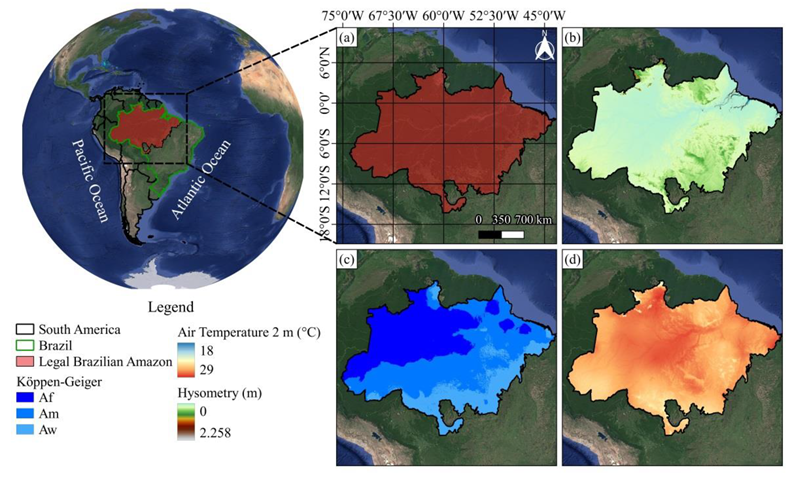

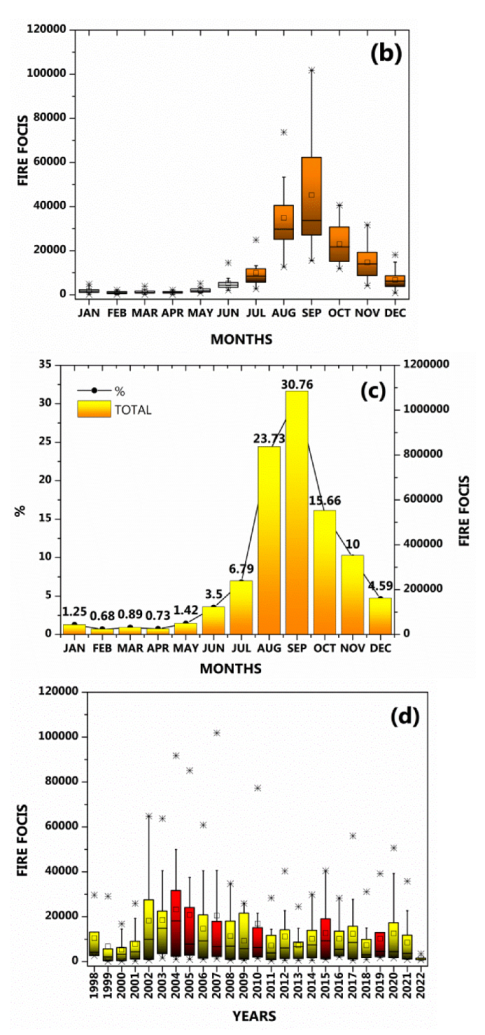
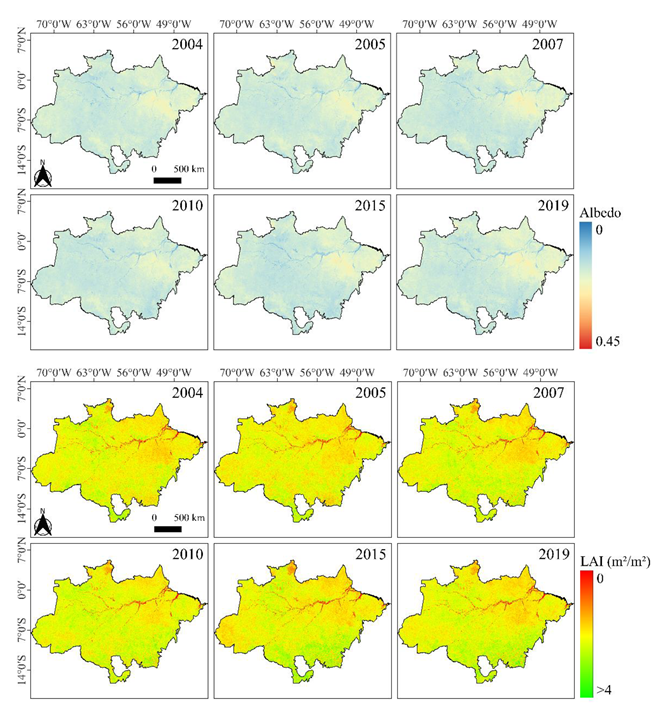
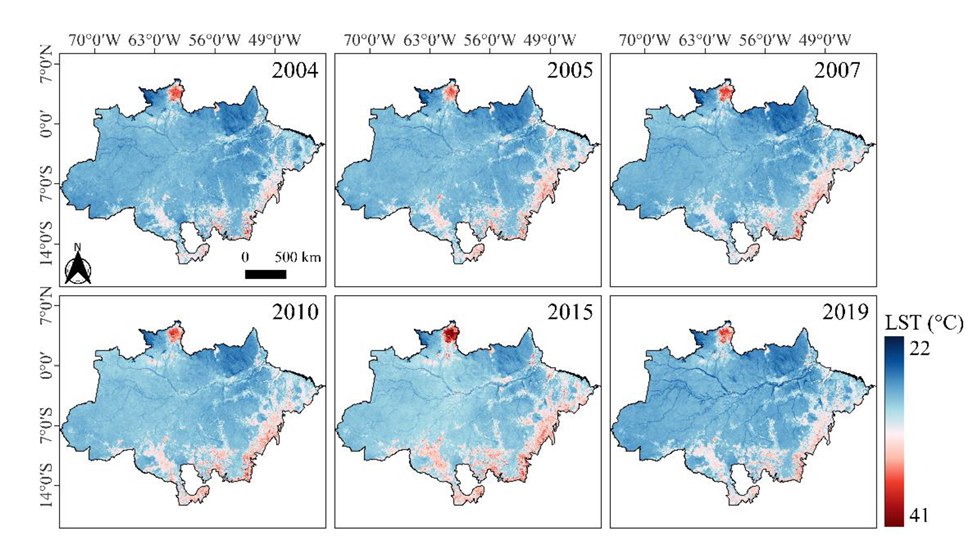

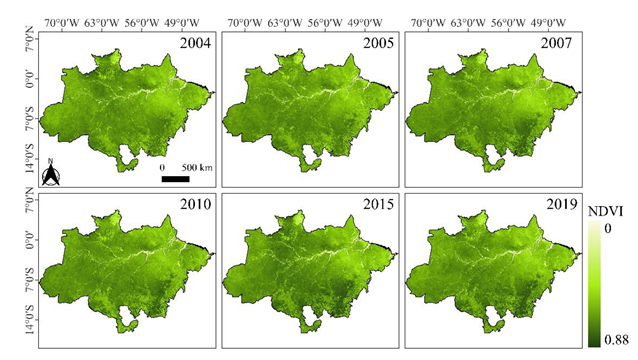
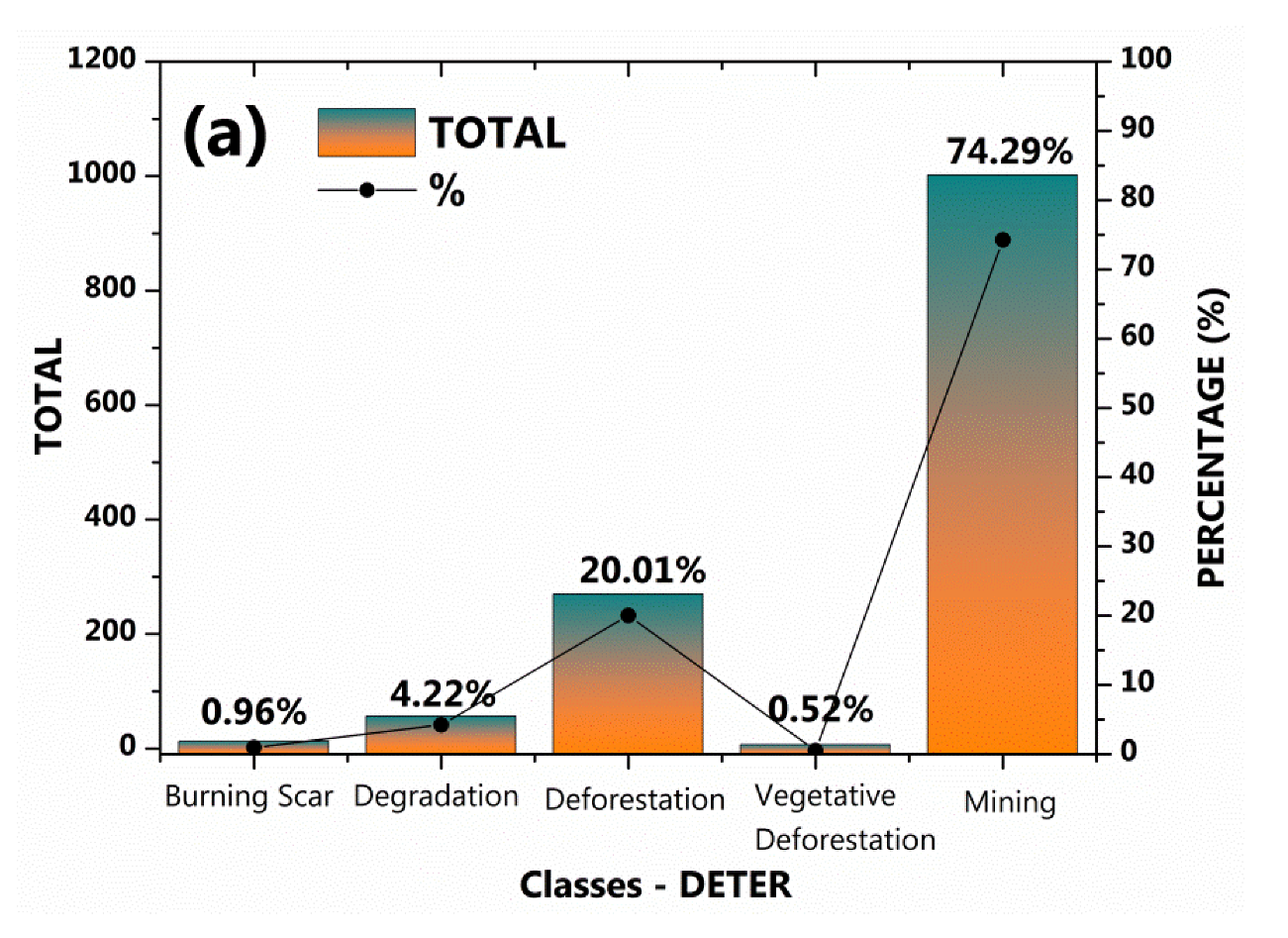
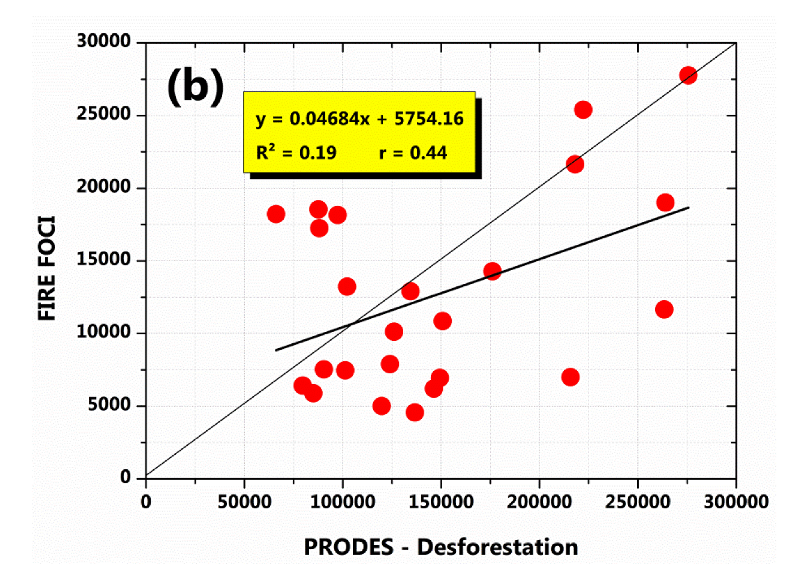

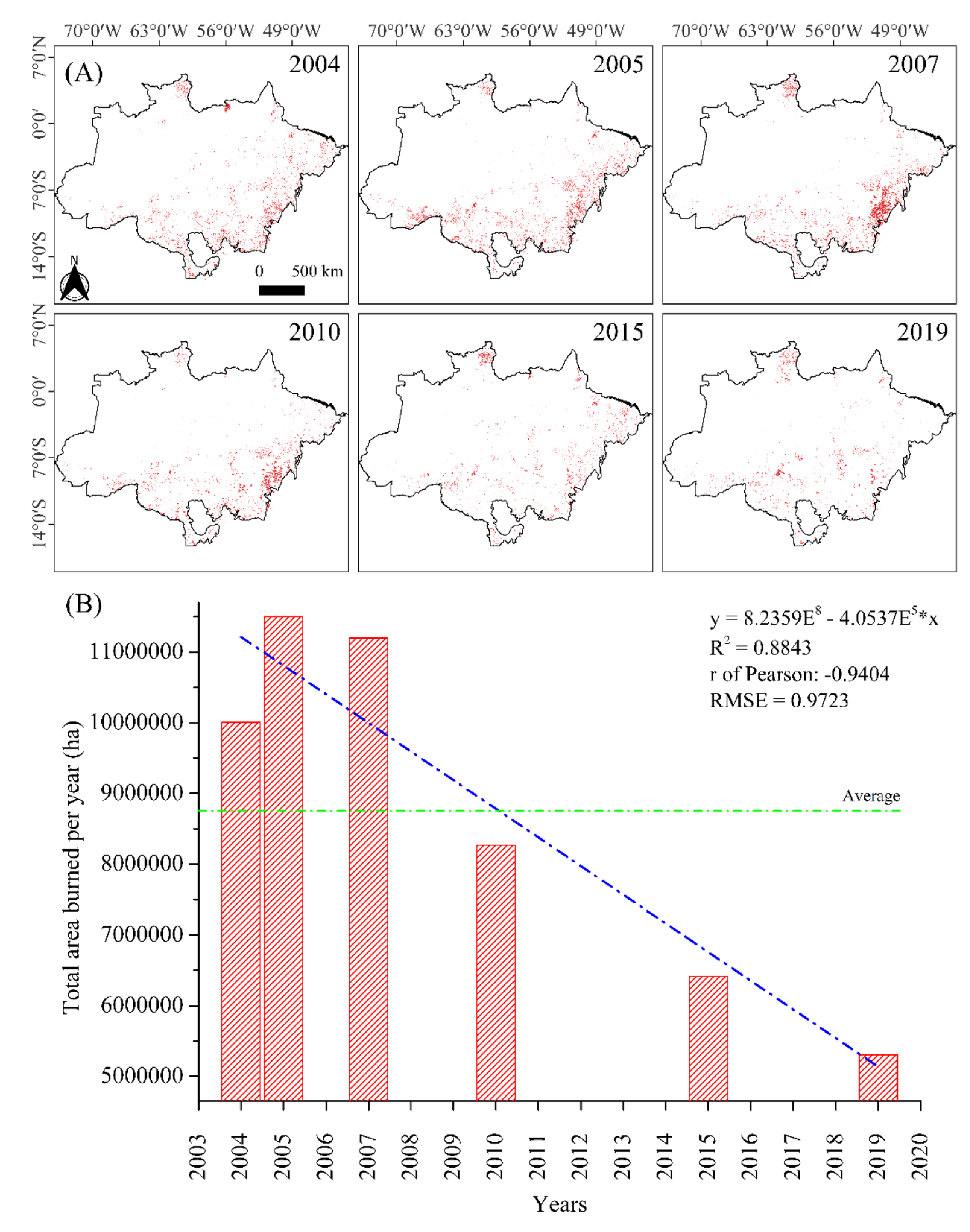
| Year | Mean | SD | Median | CV (%) | Percent (%) | Maximum | Minimum | Total | ENSO (Phases) |
|---|---|---|---|---|---|---|---|---|---|
| 1998 | 10,491.56 | 11,342.56 | 4178 | 97.8 | 2.48 | 29,680 | 2620 | 94,424 | El Niño/La Niña |
| 1999 | 6774.57 | 9704.94 | 2091.5 | 141.9 | 2.50 | 29,133 | 116 | 94,844 | La Niña |
| 2000 | 5403 | 5923.03 | 3310 | 116.2 | 1.87 | 16,813 | 123 | 75,642 | Neutral |
| 2001 | 7921.36 | 8795.90 | 4402 | 116.9 | 2.76 | 25,897 | 228 | 110,899 | La Niña |
| 2002 | 18264 | 20,780.96 | 10,014 | 122.5 | 6.18 | 64,827 | 720 | 255,696 | El Niño |
| 2003 | 18,529.88 | 17,849.76 | 14,866 | 104.4 | 6.30 | 63,683 | 1556 | 259,418 | El Niño |
| 2004 | 23,248.65 | 24,789.02 | 18,139 | 116.6 | 7.81 | 91,745 | 958 | 325,481 | El Niño |
| 2005 | 20,803.50 | 27,086.68 | 7767 | 132.5 | 7.48 | 85,108 | 967 | 291,249 | El Niño |
| 2006 | 14,723.23 | 17,541.12 | 9218 | 128.8 | 4.99 | 60,858 | 897 | 206,126 | El Niño |
| 2007 | 20,517.15 | 29,929.55 | 6736.5 | 146.7 | 7.47 | 101,816 | 1254 | 287,240 | El Niño/La Niña |
| 2008 | 11,387.93 | 12,297.75 | 6873 | 117.3 | 3.81 | 34,735 | 637 | 159,431 | La Niña |
| 2009 | 9267.50 | 9613.56 | 5826.5 | 115.0 | 2.87 | 25,876 | 510 | 129,745 | El Niño |
| 2010 | 16,943.43 | 24,314.60 | 6329 | 145.8 | 6.12 | 77,294 | 1413 | 237,208 | El Niño/La Niña |
| 2011 | 7131.78 | 8043.18 | 3888 | 129.7 | 2.26 | 28,347 | 350 | 99,845 | La Niña |
| 2012 | 11,206.56 | 12,996.70 | 6087 | 123.1 | 3.87 | 40,325 | 576 | 156,892 | Neutral |
| 2013 | 7266.86 | 6945.95 | 6736 | 106.3 | 2.41 | 24,511 | 579 | 101,736 | Neutral |
| 2014 | 10,156.65 | 10,175.45 | 7435 | 110.1 | 3.40 | 29,861 | 585 | 142,193 | El Niño |
| 2015 | 12,720.43 | 12,834.81 | 9236.5 | 113.2 | 4.15 | 40,452 | 858 | 178,086 | El Niño |
| 2016 | 10,220.79 | 9237.17 | 5516 | 95.7 | 3.52 | 28,295 | 2049 | 143,091 | El Niño |
| 2017 | 12,404.79 | 15,105.63 | 8545 | 131.3 | 4.23 | 55,994 | 522 | 173,667 | La Niña |
| 2018 | 7337.29 | 8371.83 | 3106 | 118.7 | 2.56 | 31,140 | 828 | 102,722 | La Niña |
| 2019 | 10,238.86 | 11,670.91 | 4572 | 119.3 | 3.57 | 39,176 | 1675 | 143,344 | Neutral |
| 2020 | 12,565.25 | 16,584.53 | 4466 | 132.0 | 4.27 | 50,631 | 1556 | 150,783 | La Niña |
| 2021 | 8517.50 | 10,912.55 | 3679.5 | 128.1 | 2.90 | 35,808 | 911 | 102,210 | La Niña |
| 2022 | 1494.80 | 1161.13 | 847 | 77.7 | 0.21 | 3489 | 776 | 7474 | La Niña |
| Period | DETER | PRODES | Variation (%) |
|---|---|---|---|
| 2015–2016 | 5377 km2 | 7893 km2 | 46.79% |
| 2016–2017 | 4639 km2 | 6947 km2 | 49.75% |
| 2017–2018 | 4571 km2 | 7536 km2 | 64.86% |
| 2018–2019 | 6844 km2 | 9762 km2 | 42.63% |
| States | DETER Alert Areas (Deforestation and Degradation-km2) | DETER Deforestation Alert Areas (km2) |
|---|---|---|
| Acre | 11.67 | 11.03 |
| Amapá | 0.15 | 0.15 |
| Amazonas | 228.44 | 193.28 |
| Maranhão | 8.01 | 8.01 |
| Mato Grosso | 1025.58 | 153.55 |
| Pará | 577.25 | 446.56 |
| Rondônia | 99.41 | 99.41 |
| Roraima | 7.92 | 7.92 |
| Tocantins | 0.3 | 0.3 |
| TOTAL | 2072.03 | 920.21 |
Publisher’s Note: MDPI stays neutral with regard to jurisdictional claims in published maps and institutional affiliations. |
© 2022 by the authors. Licensee MDPI, Basel, Switzerland. This article is an open access article distributed under the terms and conditions of the Creative Commons Attribution (CC BY) license (https://creativecommons.org/licenses/by/4.0/).
Share and Cite
Filho, H.d.O.; Oliveira-Júnior, J.F.d.; Silva, M.V.d.; Jardim, A.M.d.R.F.; Shah, M.; Gobo, J.P.A.; Blanco, C.J.C.; Pimentel, L.C.G.; da Silva, C.; da Silva, E.B.; et al. Dynamics of Fire Foci in the Amazon Rainforest and Their Consequences on Environmental Degradation. Sustainability 2022, 14, 9419. https://doi.org/10.3390/su14159419
Filho HdO, Oliveira-Júnior JFd, Silva MVd, Jardim AMdRF, Shah M, Gobo JPA, Blanco CJC, Pimentel LCG, da Silva C, da Silva EB, et al. Dynamics of Fire Foci in the Amazon Rainforest and Their Consequences on Environmental Degradation. Sustainability. 2022; 14(15):9419. https://doi.org/10.3390/su14159419
Chicago/Turabian StyleFilho, Helvécio de Oliveira, José Francisco de Oliveira-Júnior, Marcos Vinícius da Silva, Alexandre Maniçoba da Rosa Ferraz Jardim, Munawar Shah, João Paulo Assis Gobo, Claudio José Cavalcante Blanco, Luiz Claudio Gomes Pimentel, Corbiniano da Silva, Elania Barros da Silva, and et al. 2022. "Dynamics of Fire Foci in the Amazon Rainforest and Their Consequences on Environmental Degradation" Sustainability 14, no. 15: 9419. https://doi.org/10.3390/su14159419
APA StyleFilho, H. d. O., Oliveira-Júnior, J. F. d., Silva, M. V. d., Jardim, A. M. d. R. F., Shah, M., Gobo, J. P. A., Blanco, C. J. C., Pimentel, L. C. G., da Silva, C., da Silva, E. B., Machado, T. d. B., Pereira, C. R., Modon Valappil, N. K., Hamza, V., Haq, M. A., Khan, I., Mohamed, A., & Attia, E.-A. (2022). Dynamics of Fire Foci in the Amazon Rainforest and Their Consequences on Environmental Degradation. Sustainability, 14(15), 9419. https://doi.org/10.3390/su14159419












